|
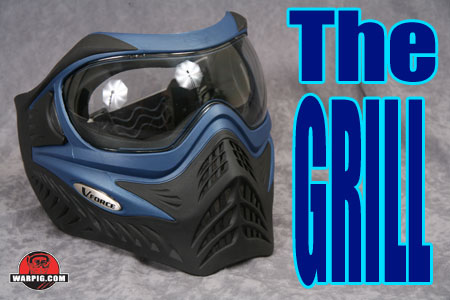
The Grill
by Bill Mills - Photos by Dawn Mills - Nov 2006
The latest offering in eye and face protection from V-Force is The Grill.
The V-Force goggle line has a lengthy history in paintball, starting with Leader goggles first distributed by Brass Eagle, and then brought into the ProCaps companies (manufacturers of DraXxus.) This lineage introduced the vertically curved lens in paintball, designed to minimize visual distortion by placing the lens at the same angle to the eye whether the wearer is looking up, down or straight ahead.
The Grill continues with the features the V-Force line has been known for – an integrated goggle and mask, fast changing lenses, unique design styling, lenses that fit over their frame rather than in a track, and vertical lens curvature. Compared the the V-Force Profiler released in 2004, the Grill has a more compact and generally aggressive appearance. Though the two masks cover a similar amount of head area, the lens portion of the Grill is not nearly as tall.
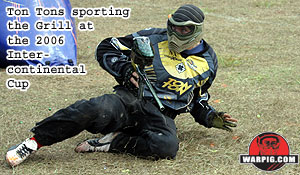 The V-Force design team faced the same challenges as other goggle designers with the Grill. Much of the market of regular paintball users makes their purchase decisions based on products they are familiar with, and one of the ways to make sure a goggle is widely seen is to make sure professional players are wearing it. As some of the most photographed people in the sport, this gets the look of the goggle on magazines and web sites around the world, not just in paid ads. To meet the demands of pro players means the mask needs to not only protect the player, but also reduce the chance of the player being eliminated from the game – a mask or goggle that is more likely to bounce a paintball than allow it to break means a player is more likely to stay in the game after a headshot, and that means a better chance of winning. The V-Force design team faced the same challenges as other goggle designers with the Grill. Much of the market of regular paintball users makes their purchase decisions based on products they are familiar with, and one of the ways to make sure a goggle is widely seen is to make sure professional players are wearing it. As some of the most photographed people in the sport, this gets the look of the goggle on magazines and web sites around the world, not just in paid ads. To meet the demands of pro players means the mask needs to not only protect the player, but also reduce the chance of the player being eliminated from the game – a mask or goggle that is more likely to bounce a paintball than allow it to break means a player is more likely to stay in the game after a headshot, and that means a better chance of winning.
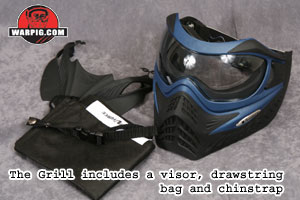 The V-Force Profiler addressed the combination of bounce factor and protection by using an over-molded structure in which a rigid jawline kept the shape of the mask, while the nose area was a softer rubber-like material. With the Grill, a more traditional approach was used, still involving the co-molding process. The goggle frame extends down forming the upper part of the mask, with stiffiner sections extending off the cheeks and supporting a rubbery lower mask section. When comparing the Grill to the Profiler head-on it is easy to see that the total surface area of the lens is greatly reduced, cutting back on one of the largest hard surfaces likely to break a paintball. The V-Force Profiler addressed the combination of bounce factor and protection by using an over-molded structure in which a rigid jawline kept the shape of the mask, while the nose area was a softer rubber-like material. With the Grill, a more traditional approach was used, still involving the co-molding process. The goggle frame extends down forming the upper part of the mask, with stiffiner sections extending off the cheeks and supporting a rubbery lower mask section. When comparing the Grill to the Profiler head-on it is easy to see that the total surface area of the lens is greatly reduced, cutting back on one of the largest hard surfaces likely to break a paintball.
 The reduced vertical size of the lens means the new mask has a slightly raised chinline, and lowered top edge. Overall the chin area provides more flex for bounces, and the lowered brow puts a head-band or angled visor in place of lens real estate where a bounce or deflection of a shot is more likely. Overmolded rubber extensions from the ear protection area of the mask run up along the browline, giving the look of angry eyebrows to the mask. The reduced vertical size of the lens means the new mask has a slightly raised chinline, and lowered top edge. Overall the chin area provides more flex for bounces, and the lowered brow puts a head-band or angled visor in place of lens real estate where a bounce or deflection of a shot is more likely. Overmolded rubber extensions from the ear protection area of the mask run up along the browline, giving the look of angry eyebrows to the mask.
Like the V-Force masks before it, the mask portion of the Grill is fully integrated to the goggle frame. This is an important protective feature, as some less than intelligent players remembering the days before face protection was considered mandatory in paintball sometimes think they can gain an advantage in communication or bounces by removing detachable masks. The problem with that concept is that in addition to protecting the areas of the face and ears which they cover, masks are critical to eye protection as well. They are designed to prevent a paintball from striking the flexible skin of the face and deflecting off the cheekbone into the eye, bypassing the goggle frame. A non-detachable mask makes paintball protection more idiot-proof.
 The flat metal V-Force nameplate found on the side of Profiler goggles has been updated for the Grill design. It is a rounded stamped metal piece, held in place by four tabs which extend through slots in the mask, and are bent over. In addition to the slots, a pair of holes are in place, hidden by the nameplate, to allow a profiler style plate or other mounting hardware to be riveted to the mask. The flat metal V-Force nameplate found on the side of Profiler goggles has been updated for the Grill design. It is a rounded stamped metal piece, held in place by four tabs which extend through slots in the mask, and are bent over. In addition to the slots, a pair of holes are in place, hidden by the nameplate, to allow a profiler style plate or other mounting hardware to be riveted to the mask.
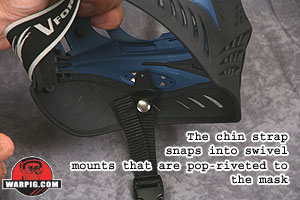 Also hidden by the nameplate is a pop rivet, which holds a pivoting chinstrap mount in place. This is a feature that was found on some of the earlier V-Force masks, but was missing in the Profiler. The chinstrap, which is included with the mask, but not pre-installed provides additional protection from accidental removal, especially for scenario and woods players who charge through heavy brush and branches. Also hidden by the nameplate is a pop rivet, which holds a pivoting chinstrap mount in place. This is a feature that was found on some of the earlier V-Force masks, but was missing in the Profiler. The chinstrap, which is included with the mask, but not pre-installed provides additional protection from accidental removal, especially for scenario and woods players who charge through heavy brush and branches.
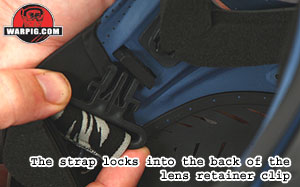 A lens that rests on its frame, rather than surrounded in a flexible track has long been a feature in the V-Force line. This design leaves little space for paint to be trapped after a lens shot. A new feature on the Grill lens is that the ridge from the Profiler's nose bridge area has been extended to the full lower rim of the lens, and a similar ridge has been added to the top edge. This provides additional protection from paint splattering or wicking around the edge of the lens to the inside of the frame. A lens that rests on its frame, rather than surrounded in a flexible track has long been a feature in the V-Force line. This design leaves little space for paint to be trapped after a lens shot. A new feature on the Grill lens is that the ridge from the Profiler's nose bridge area has been extended to the full lower rim of the lens, and a similar ridge has been added to the top edge. This provides additional protection from paint splattering or wicking around the edge of the lens to the inside of the frame.
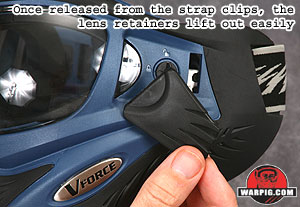 The lens locking system has undergone a restyling as well. V-Force goggles have traditionally had lenses which fit into slots on the side of the mask, and were secured in place by wedging a pair of locking tabs underneath them. When combined with the lens rim that sits on the frame rather than in a trough, this makes for a very fast lens change design. In fact when the V-Force brand line made its debut, a lens changing contest was held at the 2000 Paintball World Cup, the winner got the job done in 4.9 seconds. The lens locking system has undergone a restyling as well. V-Force goggles have traditionally had lenses which fit into slots on the side of the mask, and were secured in place by wedging a pair of locking tabs underneath them. When combined with the lens rim that sits on the frame rather than in a trough, this makes for a very fast lens change design. In fact when the V-Force brand line made its debut, a lens changing contest was held at the 2000 Paintball World Cup, the winner got the job done in 4.9 seconds.
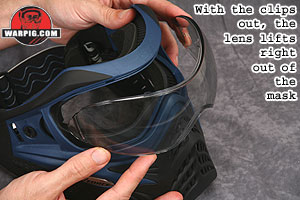 The lens itself is made from polycarbonate, and included a manufacturer's date stamp on the left side tab. In testing for review it did not produce noticeable optic distortion while worn, and the interior anti-fog coating was effective and preventing fogging even in Florida's humidity. The shape and placement of the Grill's lens does block some of the field of view compared to the Profiler and earlier models. By not extending down as far on the sides of the nose, the Grill does not offer as much downward view while the head is held level, however the loss in visual field was in an area rarely looked at during play, and had no noticeable impact during use on the field. The lens itself is made from polycarbonate, and included a manufacturer's date stamp on the left side tab. In testing for review it did not produce noticeable optic distortion while worn, and the interior anti-fog coating was effective and preventing fogging even in Florida's humidity. The shape and placement of the Grill's lens does block some of the field of view compared to the Profiler and earlier models. By not extending down as far on the sides of the nose, the Grill does not offer as much downward view while the head is held level, however the loss in visual field was in an area rarely looked at during play, and had no noticeable impact during use on the field.
For the Grill, lens attachment security has been increased. Its design uses similar locking tabs to secure the lens in place, but these tabs are not merely held in by friction. They in turn are locked in place by the clips which secure the goggle strap. This makes lens changing on the Grill a little more work than other V-Force designs, but still far easier than swapping out enclosed edge lens systems.
The Grill's strap has an overlapping slide-buckle design, making it easy to cinch tighter when on the head. On the inside of the strap, a triple row of silicone beading provides friction against slippage.
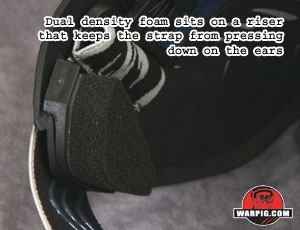 Before it reaches the lock tabs, both sides of the goggle strap pass through a pair of rigid stand-offs, that are padded with dual density foam. These stand-offs allow the Grill's ear protection to be flexible, while keeping the strap tension from pressing down on the wearer's ears. Before it reaches the lock tabs, both sides of the goggle strap pass through a pair of rigid stand-offs, that are padded with dual density foam. These stand-offs allow the Grill's ear protection to be flexible, while keeping the strap tension from pressing down on the wearer's ears.
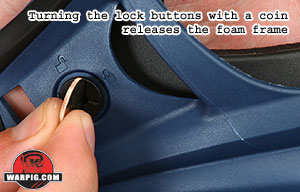 Another new feature found on the Grill is its inner frame. When the lens is removed, a pair of rotary locks are exposed. They can be turned from the locked to unlocked positions with a straight screwdriver or a coin. When unlocked the inner goggle frame, with its attached dual density foam can be lifted out of the goggle. Another new feature found on the Grill is its inner frame. When the lens is removed, a pair of rotary locks are exposed. They can be turned from the locked to unlocked positions with a straight screwdriver or a coin. When unlocked the inner goggle frame, with its attached dual density foam can be lifted out of the goggle.
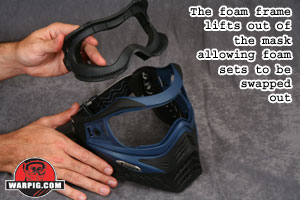 As goggle foam is a wear item, this allows for very easy replacement of the Grill's foam, or easy swapping in the middle of a long scenario game or time-out in an X-Ball game, from sweat soaked foam to a fresh dry foam set. The dual density design of the foam places a thin rigid dense layer of foam next to the frame, to retain shape, while the softer, thicker layer presses up against the player's face. As goggle foam is a wear item, this allows for very easy replacement of the Grill's foam, or easy swapping in the middle of a long scenario game or time-out in an X-Ball game, from sweat soaked foam to a fresh dry foam set. The dual density design of the foam places a thin rigid dense layer of foam next to the frame, to retain shape, while the softer, thicker layer presses up against the player's face.
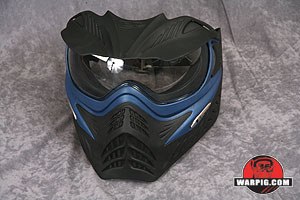 Topping the Grill is its flexible visor. The visor attaches with three tabs that pass through slots in the top of the inner frame. While earlier models used nitrile o-rings to slip over and lock tabs in place, the Grill visor has locking rings made of the same material as the visor. In fact they are molded to the visor, and left for the user to cut free, and install. Topping the Grill is its flexible visor. The visor attaches with three tabs that pass through slots in the top of the inner frame. While earlier models used nitrile o-rings to slip over and lock tabs in place, the Grill visor has locking rings made of the same material as the visor. In fact they are molded to the visor, and left for the user to cut free, and install.
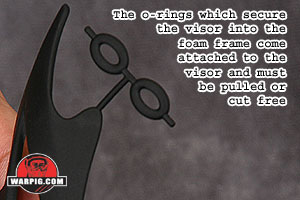 This manufacturing method not only reduces the cost of production, but also avoids problems with small o-rings being lost before the goggle system gets into the customer's hands. This manufacturing method not only reduces the cost of production, but also avoids problems with small o-rings being lost before the goggle system gets into the customer's hands.
In addition to the visor and chin strap, the Grill is packaged with a French/English instruction sheet, and a polypropelene drawstring bag.
Overall, the Grill provides comparable head coverage to the Profiler, with a more compact lens and more aggressive look as the new premier goggle model from V-Force.
|




